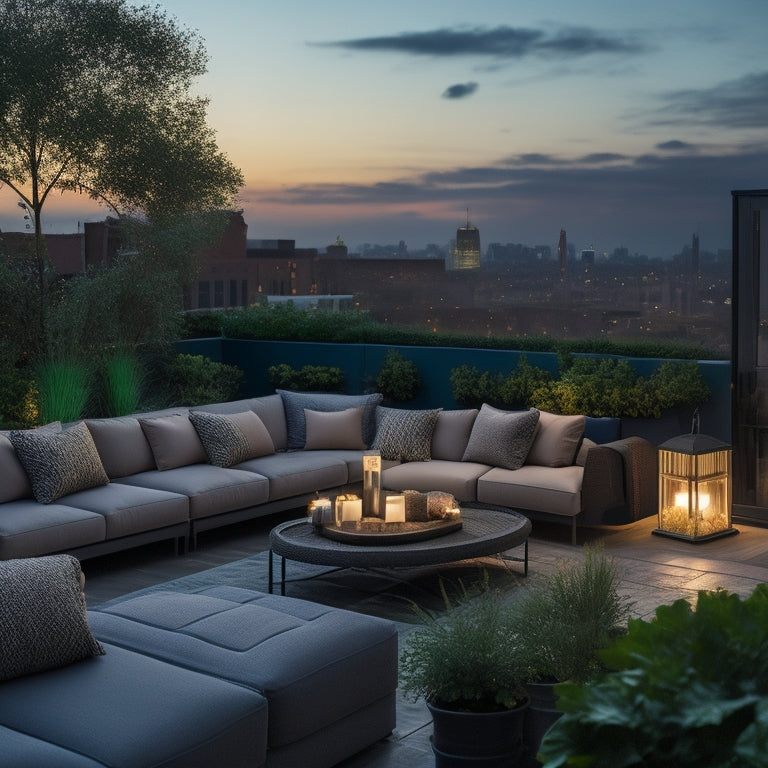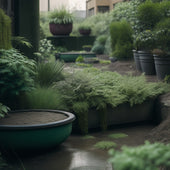
7 Essential Tips for Rooftop Seating Areas
Share
You're crafting a rooftop seating area that's both inviting and functional, and you're pinpointing the essential elements to take it from mediocre to magnificent. Start by selecting outdoor furniture that's designed for harsh weather conditions and built with durable materials like recycled plastic or stainless steel. Consider your local climate and weather patterns to inform your design, and prioritize comfort with soft cushioning and ample space for stretching. Add ambient lighting, lush greenery, and ensure safety and accessibility for all users. By incorporating these elements, you'll create a rooftop oasis that's both functional and breathtaking - and there's even more to explore to make it truly unforgettable.
Choose the Right Furniture
Select furniture that's specifically designed for outdoor use and can withstand harsh weather conditions, as rooftop seating areas are exposed to direct sunlight, strong winds, and precipitation.
When it comes to material selection, you'll want to opt for durable and weather-resistant materials like recycled plastic, stainless steel, or powder-coated aluminum. These materials can withstand the elements and require minimal maintenance.
For a stylish and modern look, consider furniture with sleek lines, minimalist designs, and bold colors. You can also choose furniture with built-in features like storage compartments, cup holders, or adjustable armrests to enhance functionality.
In terms of style options, you can choose from a variety of designs to match your rooftop seating area's aesthetic. For a cozy atmosphere, consider sectional sofas or conversation sets with plush cushions. If you prefer a more modern look, opt for sleek and minimalist chairs or stools.
Don't forget to add some decorative elements like throw pillows, planters, or outdoor rugs to complete the look. By selecting the right furniture, you'll create a comfortable and inviting rooftop seating area that you'll enjoy for years to come.
Consider Climate and Weather
When designing your rooftop seating area, you'll need to take into mind the local climate and weather patterns to guarantee your space remains functional and comfortable year-round.
You'll want to contemplate how strong winds and heavy rainfall will impact your design, as well as how to harness natural sunlight to your advantage.
Wind and Rain Protection
As you design your rooftop seating area, climate and weather conditions must be factored in to ensure that your space remains functional and comfortable, even in harsh weather circumstances. Wind and rain protection are essential elements to take into account, as they can greatly impact the usability of your outdoor space.
To mitigate wind and rain, you can incorporate various solutions into your design. Here are some options to contemplate:
| Solution | Description | Benefits |
|---|---|---|
| Shade solutions | Awnings, umbrellas, or canopies | Provides shelter from wind and rain |
| Windbreak options | Planters, screens, or walls | Blocks wind and creates a cozy atmosphere |
| Rainproof coverings | Waterproof fabrics or materials | Protects furniture and occupants from rain |
| Privacy barriers | Screens, trellises, or partitions | Creates a sense of seclusion and shields from wind |
| Retractable roofs | Motorized or manual systems | Offers flexibility and adaptability to changing weather |
Sun Exposure Considerations
During peak sun hours, your rooftop seating area's comfort level can be greatly affected by direct sunlight, which is why it's important to take sun exposure into mind when designing your space. You'll want to contemplate the climate and weather patterns in your area to ensure your seating area remains comfortable and inviting.
To mitigate the effects of direct sunlight, ponder the following:
-
Shade options: Incorporate umbrellas, canopies, or pergolas to provide relief from the sun's harsh rays. These features can also add visual interest to your space.
-
UV protection: Specify furniture and fabrics with built-in UV protection to prevent fading and damage.
-
Cooling strategies: Implement cooling features like misting systems, evaporative cooling, or fans to keep your space comfortable during hot summer months.
- Heat reflection: Use light-colored materials for flooring, walls, and furniture to reflect heat and reduce the urban heat island effect.
Opt for Comfortable Seating
When designing your rooftop seating area, you'll want to prioritize comfort to guarantee guests linger and enjoy the view.
To achieve this, focus on incorporating seating with soft cushioning that provides adequate support and relaxation.
Soft Cushioning Matters
You'll want to select rooftop seating with soft cushioning that provides adequate lumbar support and contours to the natural curves of your body, ensuring a comfortable experience for you and your guests. This is essential for creating a cozy atmosphere that invites relaxation and conversation.
Here are some key elements to keep in mind when choosing the perfect seating:
-
Thick, plush cushions that cradle your body, providing long-lasting comfort and support.
-
Colorful pillows that add a pop of color and texture to your seating area, creating a visually appealing space.
-
Cozy blankets that can be easily thrown over your shoulders on chilly evenings, keeping you warm and toasty.
- Ergonomic design that takes into account the natural curves of your body, reducing strain and discomfort.
Space for Stretching
As you configure your rooftop seating area, prioritize chairs and sofas that provide ample space for stretching, allowing you to shift positions and move freely without feeling confined or restricted. This will enable you to create a yoga corner or meditation spot where you can practice your daily routine or simply relax and unwind.
Consider sectionals or modular seating that can be arranged to accommodate different activities, such as outdoor exercise or reading.
When selecting furniture, look for pieces with sturdy frames, breathable fabrics, and adequate cushioning to guarantee comfort and support. You'll want to choose seating that allows you to stretch out your legs, lean back, or even recline, providing the ultimate relaxation experience.
A well-designed seating area will also allow you to move easily between different positions, whether you're shifting from a meditation pose to a lounging position or simply getting up to grab a snack. By incorporating space for stretching, you'll create a rooftop oasis that invites relaxation and rejuvenation.
Incorporate Ambient Lighting
Creating a warm and inviting atmosphere on your rooftop seating area requires incorporating ambient lighting that subtly illuminates the space without overpowering the senses. You want to create a relaxing ambiance that encourages socializing and lounging.
To achieve this, consider the following lighting options:
-
String lights: Suspend them above your seating area to create a cozy, intimate atmosphere.
-
Table lamps: Place them on side tables or consoles to provide soft, warm pools of light.
-
Floor lamps: Position them in corners or against walls to create a sense of depth and dimension.
- Candles: Use them sparingly to add a touch of warmth and romance to your space.
Add Some Greenery Around
To further enhance the ambiance of your rooftop seating area, surround yourself with lush plants and greenery that bring in a touch of nature and serenity. Adding some greenery around your seating area can create a calming atmosphere, perfect for relaxation. Consider incorporating vertical gardening into your design, where plants are grown upwards using a trellis or wall-mounted system. This will not only save space but also add a unique visual element to your rooftop.
When it comes to plant selection, choose varieties that are suitable for outdoor conditions and can thrive in your local climate. Consider factors such as sunlight, wind, and temperature when selecting plants.
Here are some popular plants for rooftop seating areas:
| Plant Type | Lighting Requirements | Maintenance Level |
|---|---|---|
| Succulents | Low-Moderate | Low |
| Herbs (e.g., Basil, Mint) | Moderate-High | Moderate |
| Ivy or Clematis | Low-Moderate | High |
| Ferns | Low-Moderate | Moderate |
| Grasses (e.g., Pampas, Blue Oat) | Moderate-High | High |
Ensure Safety and Accessibility
When designing your rooftop seating area, include safety features and accessibility elements that allow you to fully enjoy the space without worrying about potential hazards or obstacles.
To secure a safe and accessible space, consider the following essential elements:
-
Guardrails and railings: Install sturdy guardrails and railings to prevent falls and provide support for people with mobility issues.
-
Slip-resistant flooring: Choose flooring materials with textured surfaces or apply a non-skid coating to prevent slips and falls.
-
Wide pathways and entranceways: Design pathways and entranceways that are at least 36 inches wide to accommodate wheelchairs and strollers.
- Accessible seating options: Incorporate seating options with back support and armrests to provide comfort and accessibility for people with disabilities.
Create a Functional Layout
By carefully planning the configuration of your rooftop seating area, you can maximize its functionality and guarantee a seamless flow of traffic. To achieve this, consider the purpose of your space and the type of activities you envision taking place there. Will it be a relaxation zone, a social hub, or a combination of both? Divide the area into distinct zones, allocating space for different activities. This will help create a sense of flow and prevent congestion.
Incorporate privacy options, such as planters, screens, or partitions, to create cozy corners for intimate gatherings or solo relaxation. Versatile arrangements, like modular seating and movable planters, can be rearranged to accommodate different events or occasions.
Don't forget to include cozy nooks with built-in seating, perfect for curling up with a good book or enjoying a quiet conversation. By thoughtfully designing your rooftop seating area, you'll create a functional and inviting space that meets the needs of its users.
Frequently Asked Questions
Can Rooftop Seating Areas Be Designed for Small or Irregular Spaces?
You can definitely design rooftop seating areas for small or irregular spaces by incorporating creative solutions that maximize space, such as custom furniture with versatile designs that adapt to unique layouts and dimensions.
How Do I Prevent My Rooftop Seating Area From Being Too Windy?
"You're finally enjoying your rooftop oasis, but Mother Nature has other plans - gusty winds ruining the vibe. Create a sheltered haven by incorporating windbreak options like trellises or screens, and balance with outdoor decor suggestions, like weighty planters and sturdy furniture, to anchor the space."
Are There Any Specific Building Codes I Need to Follow for Rooftop Seating?
You'll need to navigate permit requirements and design limitations, ensuring your rooftop seating area meets local building codes, adhering to safety regulations and structural considerations to avoid costly rework or even project shutdowns.
Can I Install a Fire Pit or Outdoor Heater in My Rooftop Seating Area?
'Are you prepared to navigate the complexities of rooftop seating regulations? You'll need to guarantee your fire pit or outdoor heater meets fire pit safety standards and obtain necessary permits, considering factors like weight, ventilation, and clearance.'
Do I Need to Hire a Professional to Design and Install My Rooftop Seating Area?
You'll need to weigh DIY options against cost considerations, but if you're not experienced in structural engineering, waterproofing, and local building codes, it's highly recommended that you hire a professional to design and install your rooftop seating area.
Related Posts
-

3 Best Tool Essentials for Creative Concrete Planters
To create visually stunning and durable concrete planters, you'll need three essential tool categories. First, you'll...
-

3 Best Tool Essentials for Creative Concrete Planters
To create visually stunning and durable concrete planters, you'll need three essential tool categories. First, you'll...
-

3 Best Tool Essentials for Creative Concrete Planters
To create visually stunning and durable concrete planters, you'll need three essential tool categories. First, you'll...
-

3 Best Tool Essentials for Creative Concrete Planters
To create visually stunning and durable concrete planters, you'll need three essential tool categories. First, you'll...
-

3 Best Tool Essentials for Creative Concrete Planters
To create visually stunning and durable concrete planters, you'll need three essential tool categories. First, you'll...
-

3 Best Tool Essentials for Creative Concrete Planters
To create visually stunning and durable concrete planters, you'll need three essential tool categories. First, you'll...
-

3 Best Tool Essentials for Creative Concrete Planters
To create visually stunning and durable concrete planters, you'll need three essential tool categories. First, you'll...
-

3 Best Tool Essentials for Creative Concrete Planters
To create visually stunning and durable concrete planters, you'll need three essential tool categories. First, you'll...
-

3 Best Tool Essentials for Creative Concrete Planters
To create visually stunning and durable concrete planters, you'll need three essential tool categories. First, you'll...
-

3 Best Tool Essentials for Creative Concrete Planters
To create visually stunning and durable concrete planters, you'll need three essential tool categories. First, you'll...
-

3 Best Tool Essentials for Creative Concrete Planters
To create visually stunning and durable concrete planters, you'll need three essential tool categories. First, you'll...
-

3 Best Tool Essentials for Creative Concrete Planters
To create visually stunning and durable concrete planters, you'll need three essential tool categories. First, you'll...
-

3 Best Tool Essentials for Creative Concrete Planters
To create visually stunning and durable concrete planters, you'll need three essential tool categories. First, you'll...
-

3 Best Tool Essentials for Creative Concrete Planters
To create visually stunning and durable concrete planters, you'll need three essential tool categories. First, you'll...
-

What Makes a Great Planter for Succulents
When selecting a great planter for succulents, you'll want to take into account a combination of factors to guarantee...
-

What Makes a Great Planter for Succulents
When selecting a great planter for succulents, you'll want to take into account a combination of factors to guarantee...
-

What Makes a Great Planter for Succulents
When selecting a great planter for succulents, you'll want to take into account a combination of factors to guarantee...
-

What Makes a Great Planter for Succulents
When selecting a great planter for succulents, you'll want to take into account a combination of factors to guarantee...
-

What Makes a Great Planter for Succulents
When selecting a great planter for succulents, you'll want to take into account a combination of factors to guarantee...
-

What Makes a Great Planter for Succulents
When selecting a great planter for succulents, you'll want to take into account a combination of factors to guarantee...
-

What Makes a Great Planter for Succulents
When selecting a great planter for succulents, you'll want to take into account a combination of factors to guarantee...
-

What Makes a Great Planter for Succulents
When selecting a great planter for succulents, you'll want to take into account a combination of factors to guarantee...
-

What Makes a Great Planter for Succulents
When selecting a great planter for succulents, you'll want to take into account a combination of factors to guarantee...
-

What Makes a Great Planter for Succulents
When selecting a great planter for succulents, you'll want to take into account a combination of factors to guarantee...
-

What Makes a Great Planter for Succulents
When selecting a great planter for succulents, you'll want to take into account a combination of factors to guarantee...
-

What Makes a Great Planter for Succulents
When selecting a great planter for succulents, you'll want to take into account a combination of factors to guarantee...
-

What Makes a Great Planter for Succulents
When selecting a great planter for succulents, you'll want to take into account a combination of factors to guarantee...
-

What Makes a Great Planter for Succulents
When selecting a great planter for succulents, you'll want to take into account a combination of factors to guarantee...
-

What Makes a Great Planter for Succulents
When selecting a great planter for succulents, you'll want to take into account a combination of factors to guarantee...
-

What Makes a Great Planter for Succulents
When selecting a great planter for succulents, you'll want to take into account a combination of factors to guarantee...
-

What Makes a Great Planter for Succulents
When selecting a great planter for succulents, you'll want to take into account a combination of factors to guarantee...
-

What Makes a Great Planter for Succulents
When selecting a great planter for succulents, you'll want to take into account a combination of factors to guarantee...
-

What Makes a Great Planter for Succulents
When selecting a great planter for succulents, you'll want to take into account a combination of factors to guarantee...
-

What Makes a Great Planter for Succulents
When selecting a great planter for succulents, you'll want to take into account a combination of factors to guarantee...
-

What Makes a Great Planter for Succulents
When selecting a great planter for succulents, you'll want to take into account a combination of factors to guarantee...
-

What Makes a Great Planter for Succulents
When selecting a great planter for succulents, you'll want to take into account a combination of factors to guarantee...
-

What Makes a Great Planter for Succulents
When selecting a great planter for succulents, you'll want to take into account a combination of factors to guarantee...
-

What Makes a Great Planter for Succulents
When selecting a great planter for succulents, you'll want to take into account a combination of factors to guarantee...
-

Why Urban Gardens Need Better Planter Drainage Systems
When you neglect to install a well-designed drainage system in your urban garden, you're fundamentally sentencing you...
-

Why Urban Gardens Need Better Planter Drainage Systems
When you neglect to install a well-designed drainage system in your urban garden, you're fundamentally sentencing you...
-

Why Urban Gardens Need Better Planter Drainage Systems
When you neglect to install a well-designed drainage system in your urban garden, you're fundamentally sentencing you...
-

Why Urban Gardens Need Better Planter Drainage Systems
When you neglect to install a well-designed drainage system in your urban garden, you're fundamentally sentencing you...
-

Why Urban Gardens Need Better Planter Drainage Systems
When you neglect to install a well-designed drainage system in your urban garden, you're fundamentally sentencing you...
-

Why Urban Gardens Need Better Planter Drainage Systems
When you neglect to install a well-designed drainage system in your urban garden, you're fundamentally sentencing you...
-

Why Urban Gardens Need Better Planter Drainage Systems
When you neglect to install a well-designed drainage system in your urban garden, you're fundamentally sentencing you...
-

Why Urban Gardens Need Better Planter Drainage Systems
When you neglect to install a well-designed drainage system in your urban garden, you're fundamentally sentencing you...
-

Why Urban Gardens Need Better Planter Drainage Systems
When you neglect to install a well-designed drainage system in your urban garden, you're fundamentally sentencing you...
-

Why Urban Gardens Need Better Planter Drainage Systems
When you neglect to install a well-designed drainage system in your urban garden, you're fundamentally sentencing you...
-

Why Urban Gardens Need Better Planter Drainage Systems
When you neglect to install a well-designed drainage system in your urban garden, you're fundamentally sentencing you...
-

Why Urban Gardens Need Better Planter Drainage Systems
When you neglect to install a well-designed drainage system in your urban garden, you're fundamentally sentencing you...
-

Why Urban Gardens Need Better Planter Drainage Systems
When you neglect to install a well-designed drainage system in your urban garden, you're fundamentally sentencing you...
-

Why Urban Gardens Need Better Planter Drainage Systems
When you neglect to install a well-designed drainage system in your urban garden, you're fundamentally sentencing you...
-

Why Urban Gardens Need Better Planter Drainage Systems
When you neglect to install a well-designed drainage system in your urban garden, you're fundamentally sentencing you...
-

Why Urban Gardens Need Better Planter Drainage Systems
When you neglect to install a well-designed drainage system in your urban garden, you're fundamentally sentencing you...
-

Why Urban Gardens Need Better Planter Drainage Systems
When you neglect to install a well-designed drainage system in your urban garden, you're fundamentally sentencing you...
-

Why Urban Gardens Need Better Planter Drainage Systems
When you neglect to install a well-designed drainage system in your urban garden, you're fundamentally sentencing you...
-

Why Urban Gardens Need Better Planter Drainage Systems
When you neglect to install a well-designed drainage system in your urban garden, you're fundamentally sentencing you...
-

Why Urban Gardens Need Better Planter Drainage Systems
When you neglect to install a well-designed drainage system in your urban garden, you're fundamentally sentencing you...
-

Why Urban Gardens Need Better Planter Drainage Systems
When you neglect to install a well-designed drainage system in your urban garden, you're fundamentally sentencing you...
-

Why Urban Gardens Need Better Planter Drainage Systems
When you neglect to install a well-designed drainage system in your urban garden, you're fundamentally sentencing you...
-

Why Urban Gardens Need Better Planter Drainage Systems
When you neglect to install a well-designed drainage system in your urban garden, you're fundamentally sentencing you...
-

Why Urban Gardens Need Better Planter Drainage Systems
When you neglect to install a well-designed drainage system in your urban garden, you're fundamentally sentencing you...
-

Why Urban Gardens Need Better Planter Drainage Systems
When you neglect to install a well-designed drainage system in your urban garden, you're fundamentally sentencing you...
-

Why Urban Gardens Need Better Planter Drainage Systems
When you neglect to install a well-designed drainage system in your urban garden, you're fundamentally sentencing you...
-

Why Urban Gardens Need Better Planter Drainage Systems
When you neglect to install a well-designed drainage system in your urban garden, you're fundamentally sentencing you...
-

Why Urban Gardens Need Better Planter Drainage Systems
When you neglect to install a well-designed drainage system in your urban garden, you're fundamentally sentencing you...


